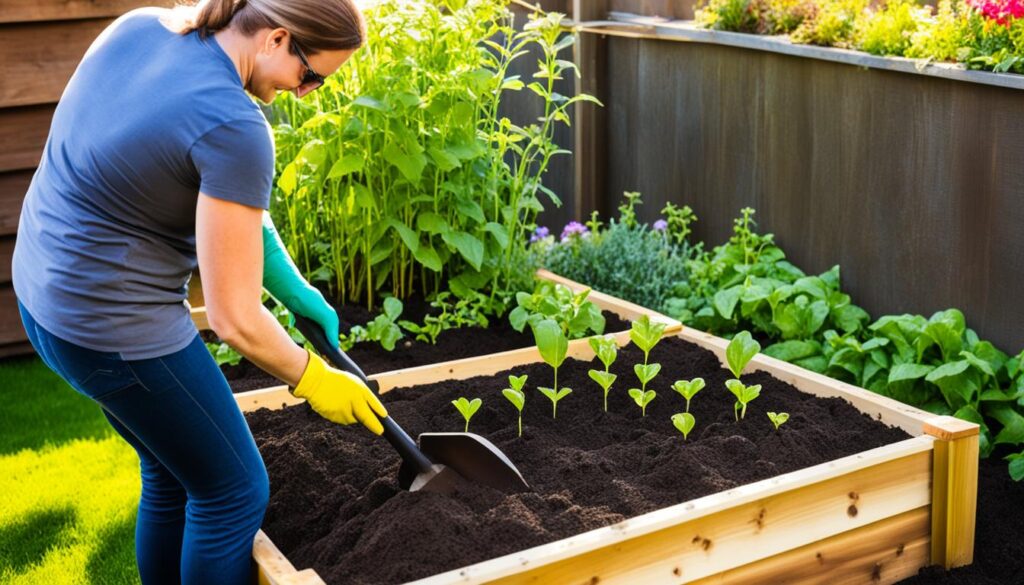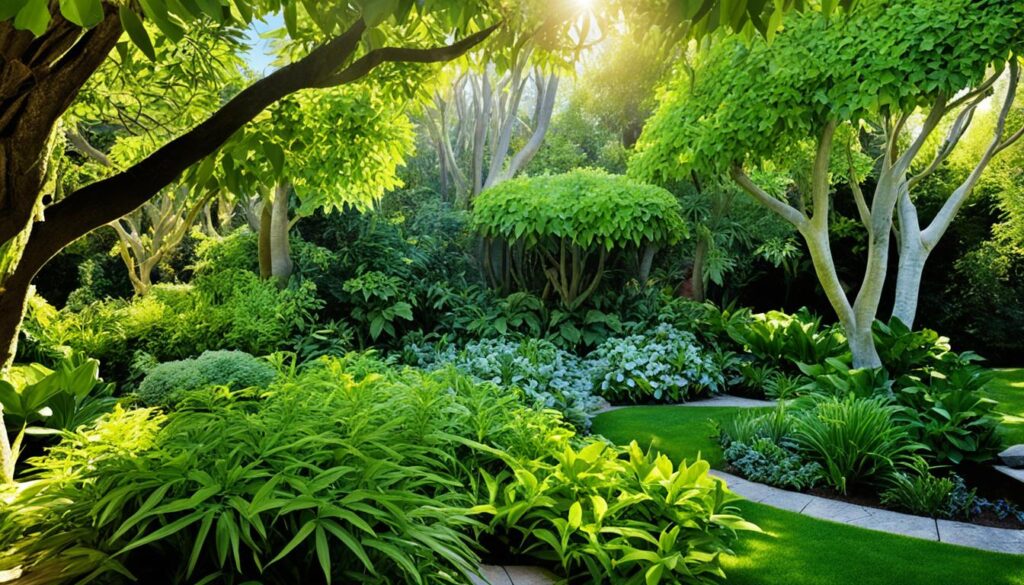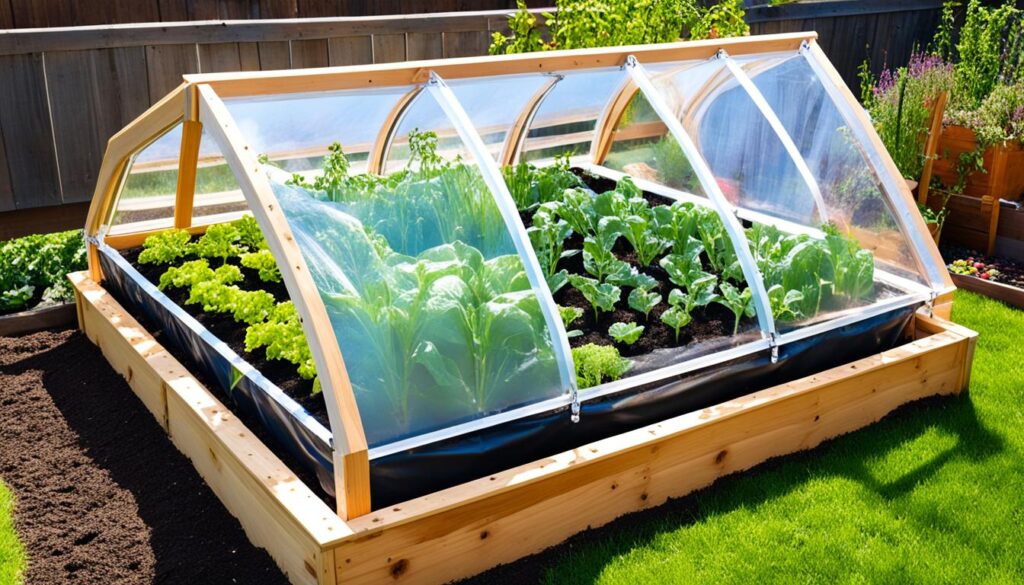Chrysanthemums are beautiful and vibrant perennials that thrive in full sun conditions. But what about growing them in shady areas? Can chrysanthemums tolerate low light and still flourish? Let’s explore whether chrysanthemums can grow in shade and discover the best shade-tolerant varieties for your garden.
Key Takeaways:
- Chrysanthemums prefer full sun but can tolerate partial shade.
- They require at least 6 hours of direct sunlight per day for robust blooms.
- The ideal growing conditions for chrysanthemums include several hours of direct sunlight, making them less suitable for shade.
- Shade-tolerant chrysanthemum varieties exist, but their blooms may be slightly less intense in low light conditions.
- If you have limited sunlight, there are other shade-tolerant flowers that may be better options for your garden.
Understanding Chrysanthemum Hardiness Zones
Chrysanthemums, or “mums” as they are commonly known, are hardy perennials that can survive year-round in specific hardiness zones. In the United Kingdom, chrysanthemums thrive in hardiness zones 5 to 9. It’s essential to understand the hardiness zone of your area before selecting chrysanthemums for your garden. The hardiness zones are determined by factors such as average minimum temperatures, which impact a plant’s ability to survive in a particular region.
If you’re unsure about the hardiness zone of your location, you can refer to the Royal Horticultural Society’s website or consult local gardening resources to find out the recommended zone for your area. Knowing your hardiness zone will help you choose chrysanthemums that are best suited to your climate and will have a higher chance of survival.
Why Consider Chrysanthemum Hardiness Zones?
Understanding chrysanthemum hardiness zones is crucial because it ensures that the plants you select are well-equipped to withstand the local climate conditions. Chrysanthemums in the correct hardiness zone have a greater chance of thriving, producing abundant blooms, and returning year after year as reliable garden additions.
When selecting chrysanthemums for your garden, pay attention to the labels or descriptions that indicate the recommended hardiness zones. These tags will typically indicate the range of zones suitable for that specific chrysanthemum variety. If your area falls outside the recommended hardiness zone range for a particular variety, it’s better to choose an alternative that is better suited to your garden’s conditions.
While chrysanthemums are hardy perennials, they can also be enjoyed as seasonal plants in areas where the climate is not ideal for year-round growth. You can still bring the beauty of chrysanthemums to your garden by planting them in pots or other containers. This way, you can move them indoors during colder months or periods of extreme weather.
| Hardiness Zone | Description | Recommended Chrysanthemums |
|---|---|---|
| Zone 5 | Minimum average temperature: -15°C to -10°C (5°F to 14°F) | Chrysanthemum ‘Polar Star’ |
| Zone 6 | Minimum average temperature: -10°C to -5°C (14°F to 23°F) | Chrysanthemum ‘Ruby Mound’ |
| Zone 7 | Minimum average temperature: -5°C to 0°C (23°F to 32°F) | Chrysanthemum ‘Golden Princess’ |
| Zone 8 | Minimum average temperature: 0°C to 5°C (32°F to 41°F) | Chrysanthemum ‘Coral Reef’ |
| Zone 9 | Minimum average temperature: 5°C to 10°C (41°F to 50°F) | Chrysanthemum ‘Sunny Deborah’ |
Table: Recommended Chrysanthemums for Each Hardiness Zone
Remember to check the specific requirements of each chrysanthemum variety you choose, as some may have additional preferences for soil type, light exposure, or watering needs. By considering the chrysanthemum hardiness zones and selecting appropriate varieties, you can enjoy the beauty and resilience of these stunning perennials in your garden.
The Difference Between Florist Mums and Garden Mums
When it comes to chrysanthemums, it’s important to understand the difference between florist mums and garden mums. Although they may look similar, these two types of chrysanthemums serve different purposes and have distinct characteristics.
Florist mums, as the name suggests, are specifically cultivated for floral displays. They are typically found in bouquets and arrangements due to their vibrant colors and large, showy blooms. These mums are not meant for outdoor planting and are more suited for indoor use or as potted plants. Florist mums require careful maintenance and are often treated with growth regulators to control their shape and size.
Garden mums, on the other hand, are hardy perennials that can withstand outdoor planting. These mums are more suitable for garden enthusiasts who want to enjoy the beauty of chrysanthemums in their outdoor spaces. Garden mums come in various sizes, shapes, and colors, and they are known for their ability to tolerate different weather conditions. They are ideal for creating vibrant autumn displays and can add a splash of color to any garden.
When choosing chrysanthemums for your garden, it is essential to select garden mums as they are specifically bred to thrive in outdoor environments. They can withstand varying weather conditions and require less maintenance compared to florist mums. Garden mums are a great choice for those who want to enjoy the beauty of chrysanthemums year after year.
| Florist Mums | Garden Mums |
|---|---|
| Intended for floral displays | Can be planted in the garden |
| Not suitable for outdoor planting | Hardy perennials |
| Used in bouquets and arrangements | Tolerant of varying weather conditions |
| Require careful maintenance | Less maintenance required |
When it comes to chrysanthemums, understanding the difference between florist mums and garden mums is crucial. Whether you prefer vibrant blooms indoors or a burst of color in your garden, choosing the appropriate type of chrysanthemums will ensure their survival and enhance the beauty of your space.

Ideal Growing Conditions for Chrysanthemums
Growing and caring for chrysanthemums requires providing them with the ideal growing conditions. By understanding their preferences, you can ensure the health and vibrancy of your chrysanthemum plants. Here are some key factors to consider:
Sunlight
Chrysanthemums thrive in a sunny spot, so it’s important to choose a location that receives at least 6 hours of direct sunlight per day. Without adequate sunlight, the plants may become leggy and produce smaller blooms. Place your chrysanthemums in a sheltered area that provides ample sunlight for their growth.
Soil
Chrysanthemums prefer moist, well-drained soil. Ensure that the soil in which you plant them has good drainage to prevent waterlogging, which can lead to root rot. Adding organic matter, such as compost or well-rotted manure, to the soil can improve its moisture-retaining capacity and overall fertility.
Watering
Regular watering is essential for chrysanthemum plant care, especially during the summer months. Keep the soil consistently moist but not waterlogged. Avoid overwatering, as it can cause root rot. Water the plants at the base, rather than overhead, to minimize the risk of fungal diseases.
Support and Maintenance
Chrysanthemums have delicate stems that may require support as they grow. Stake or cage the plants to provide them with the necessary support and prevent breakage. Additionally, pinching out side shoots and disbudding can help promote better growth and more abundant blooms. Pinching involves removing the tips of young stems to encourage branching, while disbudding involves removing excess flower buds to redirect the plant’s energy towards producing larger blooms.
In colder climates, where frost can damage chrysanthemums, you can lift the plants and store them indoors during the winter months. This will protect them from harsh weather conditions and ensure their survival for the following year.

| Growing Conditions | Optimal Requirements |
|---|---|
| Sunlight | At least 6 hours of direct sunlight per day |
| Soil | Moist, well-drained soil with good fertility |
| Watering | Regular watering to keep the soil moist |
| Support and Maintenance | Stake or cage the plants, pinch out side shoots, and disbudding |
| Winter Care | Lift and store plants indoors in colder climates |
Can Chrysanthemums Grow in Partial Shade?
While chrysanthemums are primarily sun-loving plants, they can tolerate partial shade. However, they will not thrive as well as they would in full sun conditions. If I plan to grow chrysanthemums in a location with partial shade, I must ensure it receives bright, direct light in the morning and early afternoon. Inadequate sunlight can lead to smaller blooms, leggy growth, and a decrease in the overall health and vibrancy of the plant.
In shaded areas, it’s crucial to find a balance between the limited sunlight and the plant’s need for photosynthesis. Chrysanthemums in partial shade may grow taller and have larger leaves to compensate for the reduced light. However, the lack of direct sunlight can affect their ability to produce abundant and vibrant blooms. It is recommended to provide the chrysanthemums with at least 4 to 6 hours of direct sunlight per day for optimal growth.
Factors to Consider for Chrysanthemums in Partial Shade
- Location: Choose a location where the chrysanthemums can receive the maximum amount of available sunlight.
- Timing: Ensure the chrysanthemums receive bright, direct light during the morning and early afternoon when the sun is at its strongest.
- Shade Tolerance: Select shade-tolerant chrysanthemum varieties that are specifically bred to thrive in low light conditions.
- Soil Quality: Provide well-draining and nutrient-rich soil to compensate for the limited sunlight.
- Watering: Monitor the moisture levels of the soil and adjust watering accordingly to prevent under or overwatering.
- Pruning: Regularly remove dead or decaying foliage to promote air circulation and prevent the growth of fungi.
In conclusion, while chrysanthemums can grow in partial shade, they require a delicate balance between light and shade to thrive. It is essential to provide them with adequate direct sunlight for proper growth and blooming. If partial shade is unavoidable, selecting shade-tolerant chrysanthemum varieties and providing optimal care can help achieve satisfactory results.
| Pros of Growing Chrysanthemums in Partial Shade | Cons of Growing Chrysanthemums in Partial Shade |
|---|---|
| – Allows for more flexibility in planting locations | – Smaller blooms compared to those grown in full sun |
| – Provides protection from intense heat and sunlight | – Leggy growth and weaker stems |
| – Suitable for gardens with limited sunlight | – Decreased overall plant health and vigor |
Growing Chrysanthemums in Containers and Pots
Chrysanthemums can be successfully grown in containers and pots, making them a versatile plant for smaller spaces or balconies.
When planting chrysanthemums in pots, ensure they have well-draining soil and provide ample sunlight. Regular watering and fertilizing are necessary to promote healthy growth and abundant blooms.
If you are growing chrysanthemums in pots, you can easily move them to different areas to optimize sunlight exposure.
Container gardening with chrysanthemums offers the flexibility of creating beautiful floral displays that can be rearranged to enhance your outdoor space.

Overwintering Chrysanthemums
As winter approaches, it’s important to take the necessary steps to protect your chrysanthemums and ensure their survival for the following spring. The cold temperatures and frost can be detrimental to these delicate perennials, but with proper care, you can help them overwinter successfully.
There are two main methods for overwintering chrysanthemums, depending on your location and climate. Let’s explore each option:
Lifting and Storing Chrysanthemums
If you live in an area with harsh winters, it’s recommended to lift your chrysanthemum plants and store them indoors. Follow these steps to protect your chrysanthemums during the winter months:
- Carefully dig up the chrysanthemum plants, making sure to lift the entire root ball.
- Shake off any excess soil and trim back the foliage to about 6 inches.
- Choose a cool, frost-free location to store the plants, such as a basement or garage.
- Place the chrysanthemums in pots or containers filled with moist soil or peat moss.
- Keep the plants in a well-ventilated area with indirect light.
- Monitor the soil moisture levels and water the plants sparingly to prevent them from drying out.
By following these steps, you can ensure that your chrysanthemums stay healthy and protected from the harsh winter conditions.
Protecting Chrysanthemums in the Ground
If you have hardy garden mums planted in the ground, you have the option to leave them outdoors during the winter. However, you’ll need to take additional measures to protect the roots from freezing temperatures:
- Before the first frost, apply a layer of mulch around the base of the chrysanthemum plants.
- The mulch acts as insulation, protecting the roots from extreme temperature fluctuations.
- Ensure the mulch layer is at least 3 to 4 inches thick, covering the entire root zone.
- Monitor the moisture levels in the soil and water the plants sparingly during the winter months.
- In early spring, remove the mulch once the danger of frost has passed.
By providing this added layer of protection, you can improve the chances of your chrysanthemums surviving the winter and reemerging in full glory when spring arrives.
In conclusion, overwintering chrysanthemums is essential for their survival in colder climates. Whether you choose to lift and store them or protect them in the ground, proper winter care is crucial. By following the recommended steps, you can ensure the longevity and reemergence of your chrysanthemums year after year.
Popular Chrysanthemum Varieties for Shade
While chrysanthemums prefer full sun, some varieties are more shade-tolerant than others. When it comes to growing chrysanthemums in low light conditions or shaded areas, selecting the right variety can make all the difference in their success.
Shade-Tolerant Chrysanthemum Varieties
- ‘White Majesty’: This shade-tolerant chrysanthemum variety features stunning white blooms that can add an elegant touch to any garden or floral arrangement.
- ‘Helen’: Known for its vibrant yellow flowers, ‘Helen’ is an excellent choice for shaded spots in your garden.
- ‘Alpine’: With its delicate pink petals, ‘Alpine’ chrysanthemums bring a graceful and charming beauty to shaded areas.
- ‘Lynne’: Sporting beautiful lavender blooms, ‘Lynne’ chrysanthemums can brighten up any shady corner of your garden.
These varieties have been specifically bred to thrive in low light conditions and can still produce vibrant blooms, albeit with slightly less intensity compared to those grown in full sun. When selecting chrysanthemums for shaded areas, look for varieties that are specifically labeled as shade-tolerant.
Final Thoughts on Growing Chrysanthemums in Shade
Chrysanthemums, with their vibrant blooms and striking colors, are known for their love of sunlight. However, if you find yourself with limited sunlight in your garden, it may be a challenge to grow chrysanthemums to their full potential. These sun-loving perennials thrive in full sun conditions and require at least six hours of direct sunlight per day to produce robust and abundant blooms.
If you have a shaded garden or a spot with limited sunlight, don’t despair. While chrysanthemums may not be the best choice for these conditions, there are other shade-tolerant flowers that can still add beauty to your garden. Consider alternatives like impatiens, begonias, or hostas, which are known for thriving in shaded areas. These flowers will not only bring color and life to your garden but also provide a stunning contrast to the foliage.
When selecting shade-tolerant flowers, it’s important to consider the specific growing conditions and the hardiness zones of your garden. Some flowers may tolerate partial shade better than others, so it’s crucial to choose varieties that are well-suited for your specific environment. By carefully selecting shade-tolerant flowers, you can create a beautiful and thriving garden even in areas with limited sunlight.
In conclusion, while chrysanthemums may not be the ideal choice for growing in shade, there are plenty of other flowers that can thrive in these conditions. With a little research and planning, you can find shade-tolerant flowers that will brighten up your garden and bring joy to your outdoor space, even with limited sunlight.








